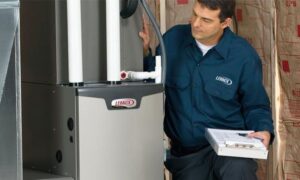As furnaces age, their efficiency naturally decreases. This can lead to higher utility bills and a less comfortable home. Homeowners should be aware of the impact of age on furnace efficiency and take steps to ensure their system is running as efficiently as possible.
There are several factors that can contribute to a furnace losing efficiency over time. One of the most significant is age. Furnaces typically last between 15 and 20 years, with older systems becoming less effective at heating a home. As components wear out, they become less efficient at converting fuel into heat, leading to higher energy bills and a less comfortable home.
Understanding Furnace Efficiency
Defining Furnace Efficiency
Furnace efficiency is a measure of how effectively a furnace converts fuel to heat. The efficiency of a furnace is represented as an Annual Fuel Utilization Efficiency (AFUE) rating. This rating is expressed as a percentage and indicates how much of the fuel is used to generate heat, with the remaining percentage lost as waste. For example, a furnace with an AFUE rating of 80% means that 80% of the fuel is used to generate heat, while 20% is lost as waste.
Factors Affecting Furnace Efficiency
Several factors affect the efficiency of a furnace. One of the most significant factors is the age of the furnace. As a furnace ages, it becomes less efficient, and its AFUE rating decreases. This is due to wear and tear on the furnace’s components, such as the heat exchanger, which can become cracked or corroded over time. As a result, the furnace may not be able to transfer heat as effectively, leading to a decrease in efficiency.
Other factors that can affect furnace efficiency include the size of the furnace, the quality of the installation, and the maintenance of the furnace. A furnace that is too small for a home may have to work harder to heat the space, leading to decreased efficiency. Similarly, a poorly installed furnace can lead to air leaks and decreased efficiency. Regular maintenance, such as replacing air filters and cleaning the furnace, can help maintain its efficiency over time.
In conclusion, understanding furnace efficiency is essential for homeowners who want to ensure their furnace is operating at maximum efficiency. By taking steps to maintain the furnace and replacing it when it reaches the end of its lifespan, homeowners can save money on their energy bills and reduce their impact on the environment.
Age-Related Decline in Furnace Performance
As furnaces age, their efficiency can decline due to various factors. Here are two main reasons why an aging furnace may lose its efficiency:
Wear and Tear Over Time
Over time, a furnace’s parts can become worn and damaged, leading to decreased efficiency. For example, the heat exchanger can develop cracks, which can cause the furnace to lose heat and work harder to maintain the desired temperature. The blower motor can also become less efficient, leading to decreased airflow and increased energy consumption.
Regular maintenance can help to reduce the effects of wear and tear on a furnace. For example, replacing air filters regularly can help to improve airflow and prevent dust and debris from accumulating on the furnace’s components. Additionally, having a professional HVAC technician perform annual maintenance can help to identify and address any issues before they become major problems.
Obsolete Technology and Parts
Another reason why an aging furnace may lose efficiency is due to outdated technology and parts. As technology advances, newer furnaces are designed to be more efficient and use less energy than older models. For example, older furnaces may have a lower AFUE (Annual Fuel Utilization Efficiency) rating than newer models, meaning that they convert less of the fuel they consume into heat for the home.
Additionally, older furnaces may use outdated or hard-to-find parts, which can make repairs more difficult and expensive. In some cases, it may be more cost-effective to replace an aging furnace with a newer, more efficient model rather than continuing to repair and maintain an older unit.
Overall, an aging furnace can experience a decline in performance and efficiency due to wear and tear and outdated technology and parts. Regular maintenance and upgrading to a newer model can help to improve efficiency and reduce energy consumption.
Assessing and Improving an Aging Furnace
Regular Maintenance and Tune-Ups
Regular maintenance and tune-ups are essential to keep an aging furnace running efficiently. According to Upgradedhome.com, a 20-year-old furnace is only 60% effective, and it will waste 40% of its heat and energy. However, with proper maintenance, homeowners can improve the efficiency of their furnace and extend its lifespan.
One of the most important maintenance tasks is to replace the air filter regularly. A dirty air filter can reduce airflow, causing the furnace to work harder and use more energy. Homeowners should replace the air filter every three months or more often if they have pets or allergies.
Another important maintenance task is to clean the furnace’s blower and motor. A dirty blower or motor can reduce the furnace’s efficiency and increase the risk of breakdowns. Homeowners should have their furnace professionally cleaned and inspected at least once a year.
When to Consider Replacement
Despite regular maintenance, an aging furnace will eventually lose efficiency and need replacement. According to McAllister Energy, gas furnaces typically last between 15 to 20 years, while electric furnaces can last up to 30 years. Homeowners should consider replacement if their furnace is over 15 years old and experiencing frequent breakdowns or high energy bills. This is especially important for winter in Gurnee, and the surrounding Illinois area as weather can be unpredictable and the temperature can drop 50+ degrees in a couple of days. This causes more stress on older furnaces requiring furnace replacements even sooner.
Replacing an aging furnace with a new, high-efficiency model can save homeowners hundreds of dollars per year on energy bills. The Department of Energy has established new energy efficiency standards for residential furnaces, which will require a minimum fuel utilization efficiency of 95 percent starting in late 2028. Homeowners should consult with a licensed HVAC professional to determine the best replacement option for their home and budget.



































